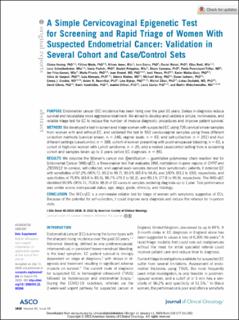A Simple Cervicovaginal Epigenetic Test for Screening and Rapid Triage of Women With Suspected Endometrial Cancer: Validation in Several Cohort and Case/Control Sets
| dc.contributor.author | Herzog, Chiara | |
| dc.contributor.author | Marín, Fátima | |
| dc.contributor.author | Jones, Allison | |
| dc.contributor.author | Evans, Iona | |
| dc.contributor.author | Reisel, Daniel | |
| dc.contributor.author | Redl, Elisa | |
| dc.contributor.author | Schreiberhuber, Lena | |
| dc.contributor.author | Paytubi, Sonia | |
| dc.contributor.author | Pelegrina, Beatriz | |
| dc.contributor.author | Carmona, Álvaro | |
| dc.contributor.author | Peremiquel-Trillas, Paula | |
| dc.contributor.author | Frias-Gomez, Jon | |
| dc.contributor.author | Pineda, Marta | |
| dc.contributor.author | Brunet, Joan | |
| dc.contributor.author | Ponce, Jordi | |
| dc.contributor.author | Matias-Guiu, Xavier | |
| dc.contributor.author | de Sanjosé, Silvia | |
| dc.contributor.author | Alemany, Laia | |
| dc.contributor.author | Olaitan, Adeola | |
| dc.contributor.author | Wong, Michael | |
| dc.contributor.author | Jurkovic, Davor | |
| dc.contributor.author | Crosbie, Emma J. | |
| dc.contributor.author | Rosenthal, Adam N. | |
| dc.contributor.author | Bjørge, Line | |
| dc.contributor.author | Zikan, Michal | |
| dc.contributor.author | Dostalek, Lukas | |
| dc.contributor.author | Cibula, David | |
| dc.contributor.author | Sundström, Karin | |
| dc.contributor.author | Dillner, Joakim | |
| dc.contributor.author | Costas, Laura | |
| dc.contributor.author | Widschwendter, Martin | |
| dc.date.accessioned | 2023-01-19T13:48:03Z | |
| dc.date.available | 2023-01-19T13:48:03Z | |
| dc.date.created | 2022-12-02T13:38:00Z | |
| dc.date.issued | 2022 | |
| dc.identifier.issn | 0732-183X | |
| dc.identifier.uri | https://hdl.handle.net/11250/3044686 | |
| dc.description.abstract | PURPOSE Endometrial cancer (EC) incidence has been rising over the past 10 years. Delays in diagnosis reduce survival and necessitate more aggressive treatment. We aimed to develop and validate a simple, noninvasive, and reliable triage test for EC to reduce the number of invasive diagnostic procedures and improve patient survival. METHODS We developed a test to screen and triage women with suspected EC using 726 cervical smear samples from women with and without EC, and validated the test in 562 cervicovaginal samples using three different collection methods (cervical smear: n = 248; vaginal swab: n = 63; and self-collection: n = 251) and four different settings (case/control: n = 388; cohort of women presenting with postmenopausal bleeding: n = 63; a cohort of high-risk women with Lynch syndrome: n = 25; and a nested case/control setting from a screening cohort and samples taken up to 3 years before EC diagnosis: n = 86). RESULTS We describe the Women's cancer risk IDentification – quantitative polymerase chain reaction test for Endometrial Cancer (WID-qEC), a three-marker test that evaluates DNA methylation in gene regions of GYPC and ZSCAN12. In cervical, self-collected, and vaginal swab samples derived from symptomatic patients, it detected EC with sensitivities of 97.2% (95% CI, 90.2 to 99.7), 90.1% (83.6 to 94.6), and 100% (63.1 to 100), respectively, and specificities of 75.8% (63.6 to 85.5), 86.7% (79.3 to 92.2), and 89.1% (77.8 to 95.9), respectively. The WID-qEC identified 90.9% (95% CI, 70.8 to 98.9) of EC cases in samples predating diagnosis up to 1 year. Test performance was similar across menopausal status, age, stage, grade, ethnicity, and histology. CONCLUSION The WID-qEC is a noninvasive reliable test for triage of women with symptoms suggestive of ECs. Because of the potential for self-collection, it could improve early diagnosis and reduce the reliance for in-person visits. | en_US |
| dc.language.iso | eng | en_US |
| dc.publisher | ASCO | en_US |
| dc.rights | Navngivelse 4.0 Internasjonal | * |
| dc.rights.uri | http://creativecommons.org/licenses/by/4.0/deed.no | * |
| dc.title | A Simple Cervicovaginal Epigenetic Test for Screening and Rapid Triage of Women With Suspected Endometrial Cancer: Validation in Several Cohort and Case/Control Sets | en_US |
| dc.type | Journal article | en_US |
| dc.type | Peer reviewed | en_US |
| dc.description.version | publishedVersion | en_US |
| dc.rights.holder | Copyright 2022 American Society of Clinical Oncology | en_US |
| cristin.ispublished | true | |
| cristin.fulltext | original | |
| cristin.qualitycode | 2 | |
| dc.identifier.doi | 10.1200/JCO.22.00266 | |
| dc.identifier.cristin | 2087787 | |
| dc.source.journal | Journal of Clinical Oncology | en_US |
| dc.source.pagenumber | 3828-3838 | en_US |
| dc.identifier.citation | Journal of Clinical Oncology. 2022, 40 (33), 3828-3838. | en_US |
| dc.source.volume | 40 | en_US |
| dc.source.issue | 33 | en_US |
Tilhørende fil(er)
Denne innførselen finnes i følgende samling(er)
-
Department of Clinical Science [2310]
-
Registrations from Cristin [9688]

